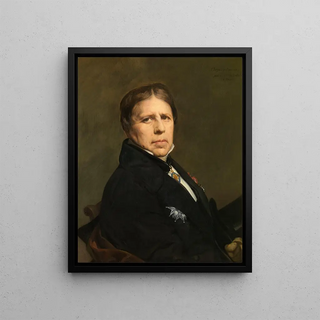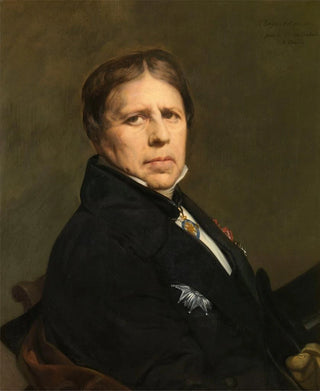Art print | Self-portrait - Jean-Auguste-Dominique Ingres


View from behind

Frame (optional)
Jean Auguste Dominique Ingres's Art print Autoportrait is much more than a simple depiction of the artist. It is a true mirror of the soul, an intimate exploration of identity and self-perception through the lens of art. Created in 1804, this art print stands out for its ability to capture not only the physical features of the artist but also his essence, aspirations, and commitment to art. In this work, Ingres does not merely paint himself; he engages in an introspection that transcends time and invites the viewer to reflect on the very nature of art and the artist.
Style and uniqueness of the work
Ingres's style is often associated with rigor and precision, characteristic of neoclassicism, but his Autoportrait also reveals a romantic sensitivity. The finesse of lines, the delicacy of details, and the harmony of colors demonstrate exceptional craftsmanship. Ingres uses light and shadow to bring his face to life, creating a depth that draws the eye and encourages exploration of the emotions hidden behind this image. The artist's posture, slightly tilted, and his penetrating gaze give the work a psychological dimension that engages the viewer in a silent dialogue. Every element, from clothing choices to facial expression, is carefully orchestrated to convey an impression of dignity and serenity, while subtly revealing vulnerability.
The artist and his influence
Jean Auguste Dominique Ingres, born in 1780, is an iconic figure in art history. A student of Jacques-Louis David, he developed a style that is uniquely his own, combining academic rigor with personal sensitivity. Ingres had a significant influence on many artists, both through his technique and thematic choices. His Autoportrait, in particular, embodies his desire to position himself as a master of art, while remaining accessible and human. He believed that art should be a quest for truth, a constant search for beauty and harmony. This vision inspired generations of artists and contributed to the evolution

Matte finish

View from behind

Frame (optional)
Jean Auguste Dominique Ingres's Art print Autoportrait is much more than a simple depiction of the artist. It is a true mirror of the soul, an intimate exploration of identity and self-perception through the lens of art. Created in 1804, this art print stands out for its ability to capture not only the physical features of the artist but also his essence, aspirations, and commitment to art. In this work, Ingres does not merely paint himself; he engages in an introspection that transcends time and invites the viewer to reflect on the very nature of art and the artist.
Style and uniqueness of the work
Ingres's style is often associated with rigor and precision, characteristic of neoclassicism, but his Autoportrait also reveals a romantic sensitivity. The finesse of lines, the delicacy of details, and the harmony of colors demonstrate exceptional craftsmanship. Ingres uses light and shadow to bring his face to life, creating a depth that draws the eye and encourages exploration of the emotions hidden behind this image. The artist's posture, slightly tilted, and his penetrating gaze give the work a psychological dimension that engages the viewer in a silent dialogue. Every element, from clothing choices to facial expression, is carefully orchestrated to convey an impression of dignity and serenity, while subtly revealing vulnerability.
The artist and his influence
Jean Auguste Dominique Ingres, born in 1780, is an iconic figure in art history. A student of Jacques-Louis David, he developed a style that is uniquely his own, combining academic rigor with personal sensitivity. Ingres had a significant influence on many artists, both through his technique and thematic choices. His Autoportrait, in particular, embodies his desire to position himself as a master of art, while remaining accessible and human. He believed that art should be a quest for truth, a constant search for beauty and harmony. This vision inspired generations of artists and contributed to the evolution






